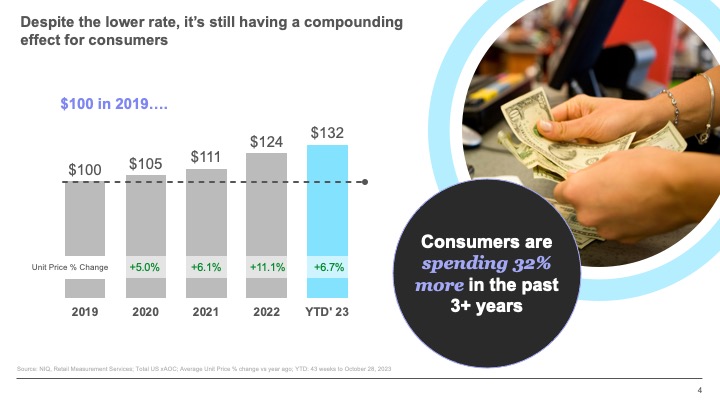The State of Food in America
In America, inequality is evident in many ways and is particularly pronounced in our dietary habits. This divide seems to be expanding, particularly in the realm of food, nutrition, and Americans’ ability to maintain a healthy lifestyle. It is, you could say, creating a tale of two American consumers.
This divide didn’t happen overnight, but at least two factors have hastened it. One is an increasing focus on food as medicine, a movement based on the practice of food and nutrition to sustain health, prevent disease, and heal bodies with dietary changes to achieve optimal health. The other is the price of food, which has risen sharply across all store categories in recent years due to inflation.
Hello, Nootropics and Adaptogens
Proactive consumers are leaning into food more than ever for health. Dietary supplements have been part of American life since the 1950s, with their use blossoming during the 1970s. The pandemic also triggered another wave of dramatic spikes for supplements as consumers pursued ways to help build their immunity systems. Fast-forward to present day, when Americans are returning to food to boost their overall health.
One emerging category is nootropics, a class of brain- and cognition-boosting supplements derived from everyday food items like eggs, blueberries, oily fish, leafy greens, coffee, dark chocolate and nuts. Over the past four years, sales of nootropic ingredients have risen 396% and are including ingredients, like nootropic mushrooms: chaga, cordyceps, and reishi.
Another burgeoning category is adaptogens, which are derived from licorice root, ashwagandha or moringa and which are said to improve mood and boost immune systems. Over the past four years, sales of adaptogens skyrocketed 257%.

Consumers Prioritizing Various Claims when Choosing Food Products
Overall, sales of foods to boost digestive health, the metabolism and immune systems, microbiomes (the collection of microorganisms in the body unique to each person) have outpaced the total food and beverage category, according to NIQ research. Searches for “gut health” are up 72% over a year ago.
It’s not all about addition, though. Americans are also looking to subtract some foods and ingredients from their diets in their search for optimal health. 67% of consumers are avoiding sugars and added sugars, sodium, hormones, and carbohydrates. 48% are steering clear of artificial ingredients and preservatives, components of “ultra-processed” foods, which make up 22% of total food and beverage sales, according to NIQ data. Consumer concerns are prompting some states, for instance California, to enact bans on some food additives.

One Country, Two Groups of Consumers
Food as medicine is expensive. Fresh reishi mushrooms run nearly $10 an ounce. Due to inflation, everyday foods, the kind that fills grocery carts, are also expensive.
Today, a consumer needs $132 to buy what $100 bought in 2019. Dry groceries and meat cost 4% more than they did in 2019. While high-income households can afford fresh, healthful food and the foods touted as medicine, households that suffer from food insecurity cannot. This group includes children, people of color, and people whose income is low but not low enough to qualify for the federal Supplemental Nutrition Assistance Program. In fact, one-third of people who face hunger do not qualify for SNAP.
The cost of fresh, healthful food is dividing America into two classes of consumers: the secure and the vulnerable. While 22% of consumers identify as being stable and secure financially, the majority are vulnerable and either struggling financially, rebounding from a financial crisis, or being cautious with their money. Ironically enough, 22% of those struggling are doing so because of a change in their health. Strugglers have higher rates of Type 2 diabetes, pre-diabetes, and obesity compared with the general population. These diseases carry a hefty price tag, with chronic ailments estimated to cost the United States $749 billion in lost productivity by 2030, according to the national Centers for Disease Control.

How We Can Close this Gap
Americans are resourceful and, with a little effort, can make fresh food and food-as-medicine available to all people, regardless of their socioeconomic status. We at NielsenIQ have identified three ways to make food and nutrition more equitable in the US.
Food policies. One example is touting and expanding the Produce Prescription program. With a Produce Prescriptions, or PRx, eligible consumers at risk for diet-related health issues, or who are food insecure, can obtain fresh and healthful produce at grocery stores for little or no cost. Find details and more info at NPPC health.
Another example is the 2023 Farm Bill, which Congress extended to September of 2024 by vote in November. Several aspects of the bill still need to be decided upon, and one is funding for SNAP, the fate of which will affect many food-insecure Americans.
Think tanks. The Food is Medicine Institute at Tufts University’s Friedman School of Nutrition Science and Policy is designed to research and promote the Food is Medicine movement, as well as produce prescriptions and other diet-related initiatives. Partners include Food & Society at the Aspen Institute, which has also informed the White House Conference on Hunger, Nutrition, and Health. More think tanks like Tufts’ could accelerate the adoption of food-as-medicine programs nationally.
More and better data. “You cannot have health equity without data equity,” says Ninez Ponce, head of the Center for Health Policy Research at the University of California – Los Angeles. One example: Data on “Asians,” a demographic that includes dozens of nationalities (from Japanese and South Asians to Filipinos and Pacific Islanders) and an array of income and educational levels, can create an inaccurate and incomplete understanding when viewed as a monolith.
In other words, the insights data yields are only as good as the data itself. NielsenIQ, with its vast data gathering and analytics resources, can help consumer-goods companies amass the best data, which in turn will yield the best and most actionable insights.
Working together, we can—and we must—make these healing and nutritious foods accessible to all. Our country’s health depends on it.





